Key to Proceratium workers of the world
The following key is based on Baroni Urbani, C., de Andrade, M.L. (2003) The ant genus Proceratium in the extant and fossil record (Hymenoptera: Formicidae). Museo Regionale di Scienze Naturali, Monografie, 36, 1–492.
1
- Mid tibiae without a pectinate spur . . . . . 2
- Mid tibiae with a pectinate spur . . . . . 12
2
return to couplet #1
- Propodeal dorsum with a swelling covered by short hairs only (Figs. 59, 63, 65) . . . . . 3
- Propodeal dorsum without swelling and covered by short and long hairs . . . . . 6
3
return to couplet #2
- Gaster entirely sculptured (Figs. 59, 60) . . . . . 4
- Gaster sculptured only in the posterior half or less (Figs. 62, 65) . . . . . 5
4
return to couplet #3
- Head and mesosoma reticulate-foveolate with superimposed granulation. Propodeal swelling broad and low. Ecuador . . . . . Proceratium ecuadoriense
- Head and mesosoma granulate only. Propodeal swelling narrow and high. Colombia . . . . . Proceratium colombicum
5
return to couplet #3
- Petiole 1/5 longer than broad. Postpetiole shorter than 1/2 of the gastral tergite I (LT4). Postpetiole and gaster more convex. Colombia . . . . . Proceratium catio
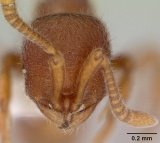 Head of Proceratium catio worker |
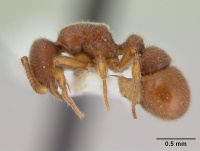 Lateral view of Proceratium catio worker |
- Petiole at most 1/8 longer than broad. Postpetiole slightly longer than ½ of the gastral tergite I (LT4). Postpetiole and gaster less convex. Brazil . . . . . Proceratium brasiliense
6
return to couplet #2
- Mid basitarsi with no hairs long 1/2 of the mid basitarsal length . . . . . 7
- Mid basitarsi with at least one hair about 1/2 of the mid basitarsal length . . . . . 8
7
return to couplet #6
- Postpetiole shorter than 1/2 of LT4. TL ≥ 3.70 mm. Dark ferruginous-brown. Dominican Republic . . . . . Proceratium taino
- Postpetiole about 1/2 of LT4. TL ≤ 3.00 mm. Light brown. Cuba . . . . . Proceratium cubanum
8
return to couplet #6
- Area between the basal and declivous faces of the propodeum with a transversal carina angulate or denticulate laterally . . . . . 9
- Area between the basal and declivous faces of the propodeum with at most very superficial traces of transversal carina . . . . . 10
9
return to couplet #8
- Postpetiole anterolaterally convex. IGR < 0.21. TL > 2.8 mm. Mexico . . . . . Proceratium mexicanum
 Head of Proceratium mexicanum worker |
 Lateral view of Proceratium mexicanum worker |
- Postpetiole anterolaterally angulate. IGR > 0.23. TL < 2.5 mm. Dominican amber . . . . . Proceratium poinari
10
return to couplet #8
- Mesosoma in profile gently convex. Postpetiole in dorsal view more convex and slightly angulate anterolaterally. Body sculpture more marked. (Fig. 67) Costa Rica, Mexico . . . . . Proceratium convexiceps
- Mesosoma in side view more elongate. Postpetiole in dorsal view more rectangular and angulate anterolaterally. Body sculpture more superficial (Figs. 74, 78) . . . . . 11
11
return to couplet #10
- TL ≥ 3.80 mm. WL ≥ 1.05 mm. Costa Rica, Panama . . . . . Proceratium panamense
- TL< 3.60 mm. WL ≤ 0.95 mm. Honduras, Costa Rica, Panama, Colombia, Venezuela. Texas?, Edcuador? . . . . . Proceratium micrommatum
 Head of Proceratium micrommatum worker |
 Lateral view of Proceratium micrommatum worker |
12
return to couplet #1
- Eyes composed by a single, large, convex facet (Fig. 43) . . . . . 13
- Eyes absent or at most composed by an agglomeration of minute ommatidia (Fig. 98) . . . . . 24
13
return to couplet #12
- Fore tibiae without thick basal spine (Fig. 155). Palp formula 3,2 . . . . . 14
- Fore tibiae with a basal spine (Fig. 38). Palp formula 4,3 . . . . . 15
14
return to couplet #13
- Clypeus surrounding the antennal socket, subrectangular and protruding anteriorly. Propodeal dorsum with a median swelling. Colombia . . . . . Proceratium transitionis
- Clypeus not surrounding the antennal socket, reduced medially and triangular. Propodeal dorsum without swelling. Venezuela . . . . . Proceratium lattkei
15
return to couplet #13
- Propodeal sides unarmed, convex in profile. Head, mesosoma, petiole and postpetiole foveolate . . . . . 16
- Propodeal sides at least with a well marked angle, or a small tooth or spine . . . . . 17
16
return to couplet #15
- Integumental foveae smaller (Fig. 36). Pilosity denser and shorter. Gaster convex in side view. IGR 0.27-0.29. Mauritius . . . . . Proceratium avium
 Head of Proceratium avium worker |
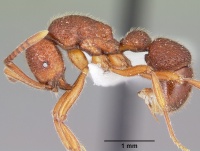 Lateral view of Proceratium avium worker |
- Integumental foveae larger (Fig. 37). Pilosity sparser and longer. Gaster in side view less convex. IGR 0.31-0.34. Mauritius . . . . . Proceratium avioide
17
return to couplet #15
- Gastral tergite I greatly hypertrophied and projecting posteriorly (Fig. 34). Funicular joints slightly longer than broad. Madagascar . . . . . Proceratium diplopyx
 Head of Proceratium diplopyx worker |
 Lateral view of Proceratium avium worker |
- Gastral tergite I round or angulate posteriorly; never projecting. Funicular joints broader than long . . . . . 18
18
return to couplet #17
- Gastral tergite I angulate on the curvature (Fig. 48). Integument from head to gastral tergite I entirely foveolate. Sarawak . . . . . Proceratium foveolatum
 Head of Proceratium foveolatum worker |
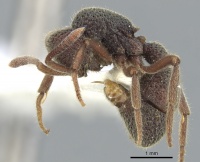 Lateral view of Proceratium foveolatum worker |
- Gastral tergite I round on the curvature. IGastral tergite I at most punctate/reticulate . . . . . 19
19
return to couplet #18
- Total length > 5.1 mm . . . . . 20
- Total length < 4.8 mm . . . . . 21
20
return to couplet #19
- Propodeal sides with an obtuse angle only. Ventral process of the petiole reduced or in shape of a very short triangle. Postpetiole about 1/4 shorter than first gastral tergite. Costa Rica . . . . . Proceratium goliath
- Propodeal sides with a tooth. Ventral process of the petiole distinct and spiniform. Postpetiole about 1/7 shorter than the first gastral tergite. Mexico . . . . . Proceratium tio
 Head of Proceratium tio worker |
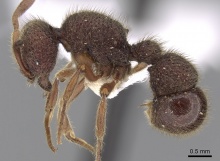 Lateral view of Proceratium tio worker |
21
return to couplet #19
- Standing hairs short (Figs. 32, 33). Propodeal sides at most toothed (Figs. 32, 33). Propodeal lobes without or at most with a narrow lamellaceous expansion . . . . . 22
- Standing hairs longer (Figs. 39, 42). Propodeal sides spinose (Figs. 39, 42), only toothed in the smallest specimens of stictum. Propodeal lobes with broad lamellaceous expansions . . . . . 23
22
return to couplet #21
- Postpetiole medially concave and laterally weakly lobate. Sculpture shallower. CI < 87. Australia (Northern Territory) . . . . . Proceratium cavinodus
 Head of Proceratium cavinodus worker |
 Lateral view of Proceratium cavinodus worker |
- Postpetiole medially straight and laterally convex. Sculpture deeper. CI > 91. Proceratium boltoni
 Head of Proceratium boltoni worker |
 Lateral view of Proceratium boltoni worker |
23
return to couplet #21
- Hind basitarsi longer, HTiL/HBaL ≥ 1.32. Cephalic sculpture superficial. Frontal carinae less divergent posteriorly. Australia (Queensland) . . . . . Proceratium stictum
 Head of Proceratium stictum worker |
 Lateral view of Proceratium stictum worker |
- Hind basitarsi shorter, HTiL/HBaL ≤ 1.17. Cephalic sculpture deeper. Frontal carinae more divergent posteriorly. Borneo, Brunei, Malaysia (Sabah and Sarawak), Thailand and Singapore . . . . . Proceratium deelemani
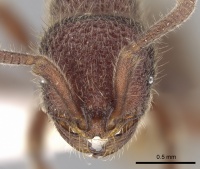 Head of Proceratium deelemani worker |
 Lateral view of Proceratium deeelemani worker |
24
return to couplet #12
- Fore tibiae with basal spine (Fig. 38) . . . . . 25
- Fore tibiae without basal spine (Fig. 155) . . . . . 35
25
return to couplet #24
- Propodeal suture impressed . . . . . 26
- Propodeal suture absent . . . . . 27
26
return to couplet #25
- Antennal socket surpassing the anterior border of the clypeus. Standing hairs suberect and present on the whole body including the antennae and the legs. Pakistan . . . . . Proceratium confinium
- Antennal socket not surpassing the anterior border of the clypeus. Standing hairs subdecumbent or decumbent, rare on the antennae and absent from the legs. United States (California) . . . . . Proceratium californicum
 Head of Proceratium californicum worker |
 Lateral view of Proceratium californicum worker |
27
return to couplet #25
- Clypeus anteriorly triangular . . . . . 28
- Clypeus anteriorly rectangular . . . . . 29
28
return to couplet #27
- Head granulopunctate. Petiole slightly longer than broad. Second tarsomere of hind legs about as long as the pretarsus. Japan . . . . . Proceratium morisitai
 Head of Proceratium morisitai worker |
 Lateral view of Proceratium morisitai worker |
- Head reticulopunctate. Petiole about as broad as long. Second tarsomere of hind legs about 1/5 longer than the pretarsus. Central and Southern Europe, Turkey . . . . . Proceratium melinum
 Head of Proceratium melinum worker |
 Lateral view of Proceratium melinum worker |
29
return to couplet #27
- Mid basitarsi shorter than fore basitarsi. First gastral tergite strongly angulate on the curvature . . . . . 30
- Mid basitarsi as long as or longer than the fore basitarsi. First gastral tergite convex or, at most weakly angulate . . . . . 31
30
return to couplet #29
- Gaster short, opaque, with dense and short hairs (Fig. 92). United States . . . . . Proceratium pergandei
 Head of Proceratium pergandei worker |
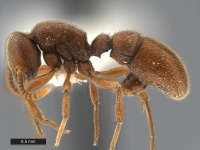 Lateral view of Proceratium pergandei worker |
- Gaster long, shining, with sparse and long hairs (Fig. 99). United States . . . . . Proceratium chickasaw
 Head of Proceratium chickasaw worker |
 Lateral view of Proceratium chickasaw worker |
31
return to couplet #29
- First funicular joint 1/2 longer than broad. Funicular joints 2-10 longer than broad. Gaster weakly angulate on the curvature . . . . . 32
- First funicular joint at most 1/3 longer than broad. Funicular joints 2-10 about as broad as long. Gaster strongly convex but without angle on the curvature . . . . . 33
32
return to couplet #31
- Scapes surpassing the vertexal margin. TL ≥ 5.5 mm. United States . . . . . Proceratium creek
 Head of Proceratium creek worker |
 Lateral view of Proceratium creek worker |
- Scapes reaching the vertexal margin. TL < 5.0 mm. United States (Texas) and North Mexico . . . . . Proceratium compitale
 Head of Proceratium compitale worker |
 Lateral view of Proceratium compitale worker |
33
return to couplet #31
- Propodeal lamellae absent. Head with sub-parallel sides. Body sculpture superficial. Malta and Sicily . . . . . Proceratium melitense
- Propodeal lamellae well developed. Head strongly narrowing posteriorly. Body sculpture deeper . . . . . 34
34
return to couplet #33
- Mesosoma, petiole and postpetiole deeply granulopunctate. Body dark ferrugineous. Japan, Korea (and China?) . . . . . Proceratium watasei
- Mesosoma, petiole and postpetiole punctate. Colour light brown. Italy, Croatia, Greece, Algeria, Morocco and Tunisia . . . . . Proceratium algiricum
35
return to couplet #24
- Frontal carinae very close to each other and posteriorly attached . . . . . 36
- Frontal carinae far from each other and posteriorly diverging . . . . . 38
36
return to couplet #35
- Head and mesosoma strongly and irregularly foveolate. Genal carinae strongly impressed. Propodeal lamellae developed. First gastral sternite flat. Postpetiole and first gastral tergite covered by foveae. Sabah . . . . . Proceratium microsculptum
 Head of Proceratium microsculptum worker |
 Lateral view of Proceratium microsculptum worker |
- Head and mesosoma granulate. Genal carinae absent. Propodeal lamellae dabsent. First gastral sternite tooth-shaped and projecting anteriorly. Postpetiole and first gastral tergite without foveae . . . . . 37
37
return to couplet #36
- Head and mesosoma with suberect hairs. Kenya . . . . . Proceratium toschii
- Head and mesosoma with subdecumbent or decumbent hairs. Cameroon . . . . . Proceratium terroni
38
return to couplet #35
- Head, mesosoma, petiole and postpetiole covered by granulation only. Clypeus anteromedially with a triangular tooth. Posterior border of the first gastral tergite without macula visible in transparency . . . . . 39
- Head, mesosoma, petiole and postpetiole never covered by granulation only. Clypeus anteromedially at most with a subround small tooth. Posterior border of the first gastral tergite with a clear macula visible in transparency . . . . . 41
39
return to couplet #38
- Body hairs short, decumbent or appressed. Bhutan . . . . . Proceratium bhutanense
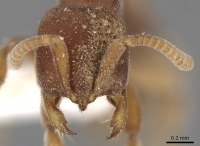 Head of Proceratium bhutanense worker |
 Lateral view of Proceratium bhutanense worker |
- Body with long standing hairs . . . . . 40
40
return to couplet #39
- Propodeal sides at most with a narrow lamella surrounding the propodeal lobe only. Mid basitarsi with hairs shorter than 1/2 of the mid basitarsus length. Palp formula 4,3. Japan, Korea?, China? . . . . . Proceratium itoi
 Head of Proceratium itoi worker |
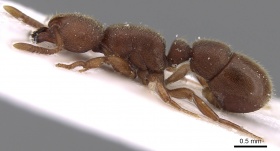 Lateral view of Proceratium itoi worker |
- Propodeal sides with a broad lamella on their whole length. Mid basitarsi with hairs 1/2 of the mid basitarsus length. Palp formula 3,2. Malaysia . . . . . Proceratium malesianum
 Head of Proceratium malesianum worker |
 Lateral view of Proceratium malesianum worker |
41
return to couplet #38
- Lower mesopleura inflated (Figs. 121, 122, 124). Clypeus either with a small median subround projection or, if straight, minutely crenulate. Palp formula 3,2 or 4,3. Mandibular base without macula. Petiole with a neck . . . . . 42
- Mesopleura never inflated (Figs. 139, 146, 159). Clypeus weakly concave or, if straight, never crenulate. Palp formula 2,2. Mandibular base with a light macula. Petiole without neck . . . . . 45
42
return to couplet #41
- Mesosoma and petiole with very superficial traces of foveae. Petiolar dorsum postero-medially with a large, transparent blister below the integument. Lower mesopleurae entirely inflated. Palp formula 4,3. Israel . . . . . Proceratium galilaeum
- Head, mesosoma, petiole, postpetiole and gaster with foveae variably impressed. Petiolar dorsum postero-medially with at most an irregular point. Lower mesopleurae inflated posteriorly only. Palp formula 3,2 . . . . . 43
43
return to couplet #42
- Integumental foveae superficial. First gastral tergite longer than 1/4 of the postpetiole. Zimbabwe . . . . . Proceratium arnoldi
 Head of Proceratium arnoldi worker |
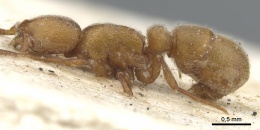 Lateral view of Proceratium arnoldi worker |
- Integumental foveae deep. First gastral tergite short, 1/7 or less of the postpetiole . . . . . 44
44
return to couplet #43
- Integumental foveae small. Gastral sculpture superficial (Fig. 122). Burundi . . . . . Proceratium burundense
 Head of Proceratium burundense worker |
 Lateral view of Proceratium burundense worker |
- Integumental foveae large and deep. Gastral sculpture deep (Fig. 121). Cameroon . . . . . Proceratium lunatum
 Head of Proceratium lunatum worker |
 Lateral view of Proceratium lunatum worker |
45
return to couplet #41
- Petiole in profile triangular and clearly narrowing apically (Figs. 126,
127) . . . . . 46
- Petiole in profile rectangular (Figs. 141, 148) . . . . . 47
46
return to couplet #45
- Lateral expansions of the frontal carinae broad and far from each other. Head with dense punctures (Fig. 126). SI > 76. TL > 4.5 mm. Fiji Islands . . . . . Proceratium relictum
 Head of Proceratium relictum worker |
 Lateral view of Proceratium relictum worker |
- Lateral expansions of the frontal carinae narrow and close each other. Head with sparse punctures (Fig. 127). SI < 73. TL < 3.7 mm. Fiji Islands . . . . . Proceratium oceanicum
 Head of Proceratium oceanicum worker |
 Lateral view of Proceratium oceanicum worker |
47
return to couplet #45
- Postpetiole concave and laterally lobate in dorsal view. Posterior border of first gastral tergite with a fold. Head, mesosoma, petiole, postpetiole and gaster strongly sculptured. First gastral tergite with traces of longitudinal rugostties . . . . . 48
- Postpetiole in dorsal view neither concave nor laterally lobate. Posterior border of first gastral tergite not folded. Head, mesosoma, petiole, postpetiole and gaster less strongly sculptured. First gastral tergite without traces of longitudinal rugosities . . . . . 49
48
return to couplet #47
- Frontal area at least 1/3 of the head width. Propodeal sides with at most a small denticle. Rugosities on the first gastral tergite irregular and thin (Fig. 146). SI < 65. Sarawak . . . . . Proceratium angulinode
- Frontal area about 1/4 of the head width. Propodeal sides with a broad, lamelliform tooth. Rugosities on the first gastral tergite regular and thick (Fig. 147). SI > 74. Sarawak . . . . . Proceratium striativenter
49
return to couplet #47
- CI < 85. Australia (New South Wales) . . . . . Proceratium gigas
- CI > 89 . . . . . 50
50
return to couplet #49
- TL ≤ 2.3 mm. Frontal area about 1/4 of HW . . . . . 51
- TL ≥ 2.37 mm if the TL approaches 2.3 mm, (papuanum specimens can vary between 2.37-2.59 mm), then the frontal area about 1/3 of HW . . . . . 52
51
return to couplet #50
- Head and mesosoma with marked reticulation. Petiole more than 1 and 1/2 broader than long. CI ≥ 100. Papua New Guinea . . . . . Proceratium snellingi
- Head and mesosoma with superficial punctures. Petiole 1 and 1/2 broader than long. CI < 95. Papua New Guinea . . . . . Proceratium ivimka
52
return to couplet #50
- Species with the combination of the following characters: frontal area slightly narrower than 1/3 of HW; TL varying between 2.3 and 2.7 mm; petiole at least 1 and 1/2 broader than long (PeW ≤ 0.27 mm); propodeal sides at most denticulate; HbaL ≤ 0.24; mid basitarsi with a hair at least 2/3 of basitarsal length; hind basitarsi with a hair at least 1/2 of its length (Fig. 134). Papua New Guinea, Philippines, Sumatra, Malaysia, Sabah and Solomon Islands . . . . . Proceratium papuanum
 Head of Proceratium papuanum worker |
 Lateral view of Proceratium papuanum worker |
- Species without the above mentioned combination of characters . . . . . 53
53
return to couplet #52
- Species with the combination of the following characters: frontal area at most 1/4 of HW. TL 2.4 - 2.7 mm; petiole more than 1 and 1/2 broader than long (PeW 0.33 mm); HbaL ≤ 0.26; mid basitarsi with hairs shorter than 2/3 of their length; hind basitarsi with hairs shorter than 2/3 of their length (Fig. 138). Queensland (Australia) . . . . . Proceratium pumilio
 Head of Proceratium pumilio worker |
 Lateral view of Proceratium pumilio worker |
- Species without the above mentioned combination of characters . . . . . 54
54
return to couplet #53
- Species with the following combination of characters: SI > 73; body with many long, standing hairs; frontal area at least 1/3 of the maximum HW; propodeal sides at most subangulate (Fig. 135). Australia (Queensland) . . . . . Proceratium hirsutum
 Head of Proceratium hirsutum worker |
 Lateral view of Proceratium hirsutum worker |
- Species without the above combination of characters . . . . . 55
55
return to couplet #54
- Species with the combination of the following characters: frontal area slightly less than 1/4 of the maximum HW; petiole narrower than 1 and 1/2 of its length; integument smooth and shining (Fig. 132). New Caledonia . . . . . Proceratium caledonicum
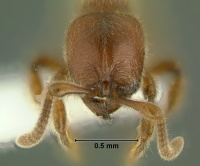 Head of Proceratium caledonicum worker |
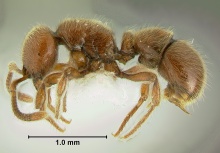 Lateral view of Proceratium caledonicum worker |
- Species without the above mentioned combination of characters . . . . . 56
56
return to couplet #55
- Species with the combination of the following characters: frontal area at least 1/3 of the maximum HW; petiole about 1 and ½ broader than its length; head, mesosoma, petiole, postpetiole and gaster smooth and shining (Fig. 131). New Caledonia . . . . . Proceratium politum
 Head of Proceratium politum worker |
 Lateral view of Proceratium politum worker |
- Species without the above mentioned combination of characters . . . . . 57
57
return to couplet #56
- Species with the following combination of characters: TL > 3.7 mm.; frontal area broader than 1/3 of the maximum HW; petiole less than 1 and 1/2 broader than long; mid basitarsi with hairs shorter than 1/2 of their length (Fig. 153). United States . . . . . Proceratium croceum
 Head of Proceratium croceum worker |
 Lateral view of Proceratium croceum worker |
- Species without the above mentioned combination of characters . . . . . 58
58
return to couplet #57
- Species with the following combination of characters: petiole less than 1 and 1/2 broader than long; frontal area 1/4 of HW; head, mesosoma, petiole and postpetiole densely granulopunctate; mid basitarsi with at least one hair 2/3 of their length; hind basitarsi with at least one hair 1/2 of their length. SI < 70. CI < 91 (Fig. 136). Thailand . . . . . Proceratium siamense
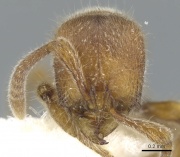 Head of Proceratium siamense worker |
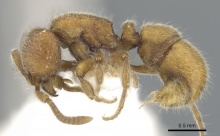 Lateral view of Proceratium siamense worker |
- Species without the above mentioned combination of characters . . . . . 59
59
return to couplet #58
- Species with the following combination of characters: frontal area slightly narrower than 1/3 of the maximum HW; head densely punctate; mesosoma, petiole, postpetiole and gaster smooth and shining; SI > 70. CI > 94; propodeal sides clearly angulate or denticulate (Fig. 133). Malaysia (Pahang) . . . . . Proceratium terraealtae
 Head of Proceratium terraealtae worker |
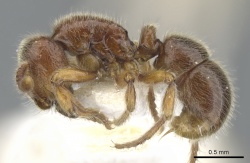 Lateral view of Proceratium terraealtae worker |
- Species without the above mentioned combination of characters . . . . . 60
60
return to couplet #59
- Species with the following combination of characters: hairs of mid basitarsi never longer than 1/2 of the basitarsal length; hind basitarsi with at least a hair slightly longer than 1/3 of their length . . . . . 61
- Species with the combination of the following characters: mid basitarsi with at least a hair 2/3 of their length; hind basitarsi with at least a hair about 1/2 of their length . . . . . 67
61
return to couplet #60
- Propodeal sides at most angulate. Postpetiole and gaster smooth and shining . . . . . 62
- Propodeal sides with a small denticle, if subangulate, the postpetiole is always sculptured . . . . . 63
62
return to couplet #61
- Standing hairs on the gaster very sparse and suberect. Mid basitarsi with hairs at most 1/3 of the basitarsal length. CI < 93. SI > 68. Australia (Queensland) . . . . . Proceratium gracile
 Head of Proceratium gracile worker |
 Lateral view of Proceratium gracile worker |
- Standing hairs on the gaster denser, subdecumbent and decumbent. Mid basitarsi with hairs about 1/2 of the basitarsal length. CI > 94. SI < 65. Australia (New South Wales) . . . . . Proceratium robustum
 Head of Proceratium robustum worker |
 Lateral view of Proceratium robustum worker |
63
return to couplet #61
- Species with the following combination of characters: frontal area 1/3 HW; PeW ≤ 0.29 mm; postpetiole very sparsely granulopunctate (Fig. 142). Tunisia, Cyprus, Algeria, Turkey and Albania . . . . . Proceratium numidicum
- Species without the above mentioned combination of characters . . . . . 64
64
return to couplet #63
- Mesosoma and postpetiole strongly granulopunctate (Figs. 129, 143) . . . . . 65
- Mesosoma and postpetiole less strongly granulopunctate (Figs. 159, 165) . . . . . 66
65
return to couplet #64
- Frontal area 1/4 of HW (Fig. 129). Colour dark ferruginous. Sarawak . . . . . Proceratium dayak
 Head of Proceratium dayak worker |
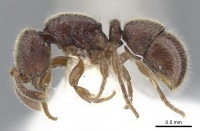 Lateral view of Proceratium dayak worker |
- Frontal area slightly narrower than 1/3 of HW (Fig. 143). Colour yellow to brown. Japan, Taiwan . . . . . Proceratium japonicum
 Head of Proceratium japonicum worker |
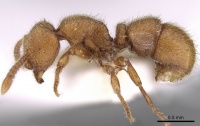 Lateral view of Proceratium japonicum worker |
66
return to couplet #64
- Frontal area about 1/4 of HW and frontal carinae gently diverging posteriorly (Fig. 165). Standing hairs on the postpetiole and gaster sparser and shorter. United States . . . . . Proceratium crassicorne
 Head of Proceratium crassicorne worker |
 Lateral view of Proceratium crassicorne worker |
- Frontal area larger than 1/4 of HW and frontal carinae strongly diverging on the two anterior thirds (Fig. 159). Standing hairs on the postpetiole and gaster denser and longer. Southern Canada and United States . . . . . Proceratium silaceum
 Head of Proceratium silaceum worker |
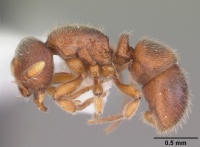 Lateral view of Proceratium silaceum worker |
67
return to couplet #60
- Mesosoma, petiole and postpetiole minutely punctate only. Papua New Guinea, and Solomon Islands? . . . . . Proceratium austronesicum
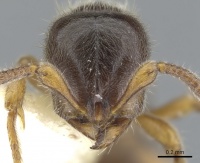 Head of Proceratium austronesicum worker |
 Lateral view of Proceratium austronesicum worker |
- Mesosoma, petiole and postpetiole densely punctate and variably granulate . . . . . 68
68
return to couplet #67
- Posterior half of the head dorsum and anterior half of the mesosoma smooth and minutely punctate. Petiole less than 1 and 1/2 broader than long. Mexico, Belize, Guatemala?, Honduras, Costa Rica, and Colombia . . . . . Proceratium mancum
 Head of Proceratium mancum worker |
 Lateral view of Proceratium mancum worker |
- Species without the above mentioned combination of characters . . . . . 69
69
return to couplet #68
- CI > 98. Sarawak (Malaysia) . . . . . Proceratium sulawense
 Head of Proceratium sulawense worker |
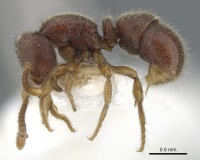 Lateral view of Proceratium sulawense worker |
- CI < 97 . . . . . 70
70
return to couplet #69
- IGR 0.44. First gastral tergite strongly convex (Fig. 148). Sabah . . . . . Proceratium banjaranense
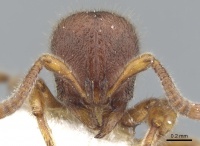 Head of Proceratium banjaranense worker |
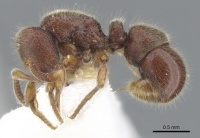 Lateral view of Proceratium banjaranense worker |
- IGR ≥ 0.48. First gastral tergite less convex (Figs. 137, 149) . . . . . 71
71
return to couplet #70
- Mesosoma, petiole and postpetiole densely granulopunctate. Sabah . . . . . Proceratium dusun
 Head of Proceratium dusun worker |
 Lateral view of Proceratium dusun worker |
- Mesosoma, petiole and postpetiole punctate and sparsely granulate. Australia (Queensland, New South Wales) . . . . . Proceratium australe
 Head of Proceratium australe worker |
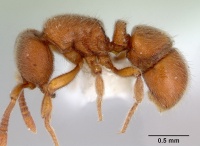 Lateral view of Proceratium australe worker |